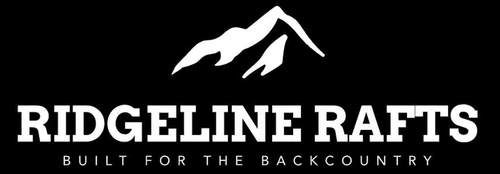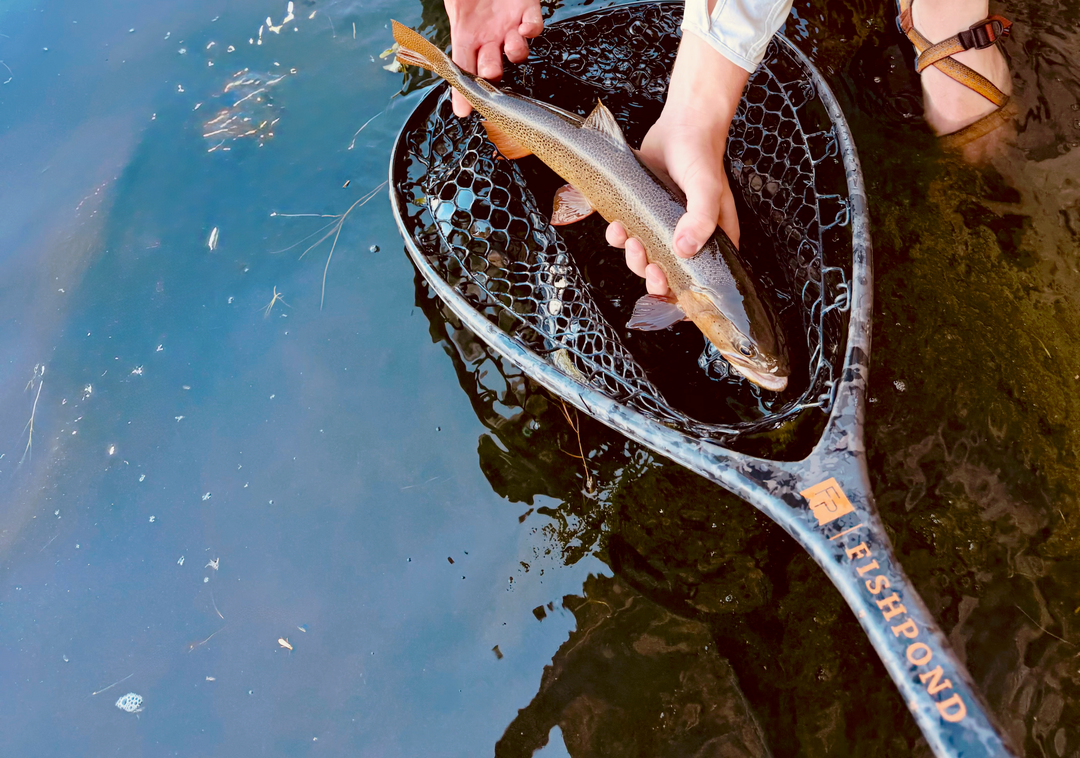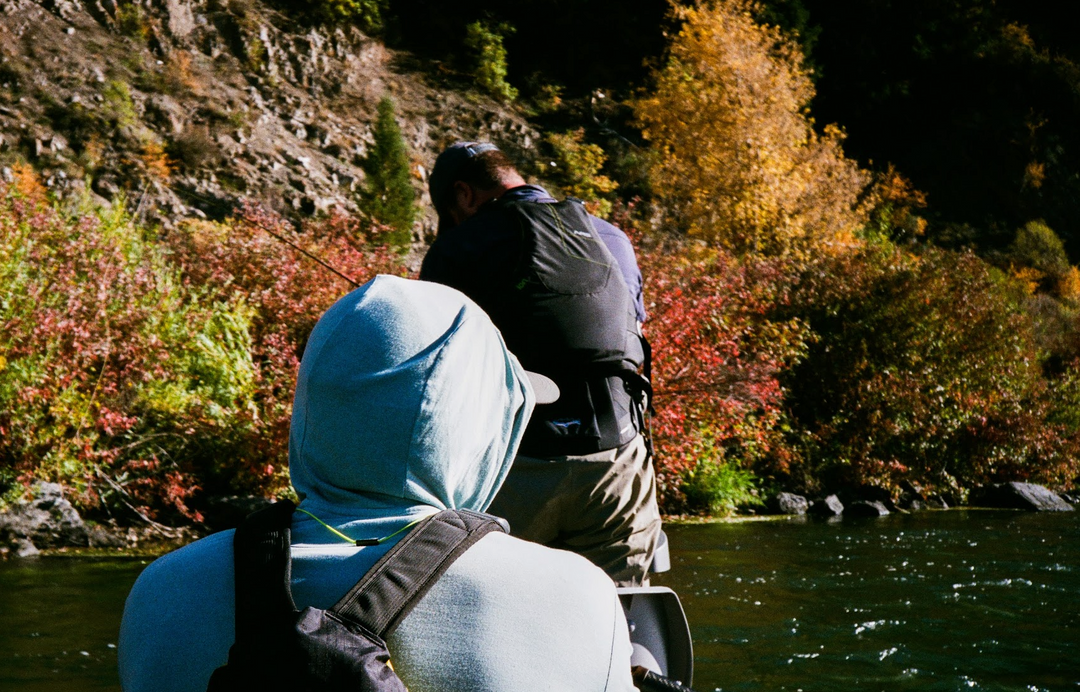What are Inflatable Pontoon Boats?
Pontoon-style inflatable boats have become a common sight on rivers and lakes, especially among fly anglers looking for a compact, typically solo fishing setup. Their lightweight design and twin-hull layout offer certain advantages, like portability and access to shallower or more remote waters—without needing a trailer or full-sized drift boat most of the time.
But like any piece of gear, they come with tradeoffs. While some anglers appreciate the simplicity of pontoon boats, others quickly run into limitations when it comes to stability, gear capacity, or navigating technical water.
In this guide, we’ll take a closer look at what inflatable pontoon boats are, how they’re typically used, and what to consider if you’re weighing one against other options—like a purpose-built fly fishing raft. Whether you’re new to fishing from a boat or thinking about upgrading your setup, understanding the pros and cons of pontoon-style boats is a great place to start.
What is an Inflatable Pontoon Boat
An inflatable pontoon boat is a compact watercraft made up of two inflatable tubes (or pontoons) connected by a metal frame—sometimes with a small seat or platform added for gear. It’s designed primarily for solo anglers who need a lightweight, packable option to reach shallow or hard-to-access water.
These boats aim to strike a balance between portability and stability. The pontoons are usually made from materials like PVC or urethane-coated fabric, while the frames are commonly built from steel or aluminum to keep weight manageable. Most setups can support an angler and some basic gear, with weight capacities typically ranging from 275 to 800 pounds (this is total weight - people, gear, food, etc).
Inflatable pontoon boats are often chosen for their ability to reach areas that would be difficult for drift boats or motorized craft—such as shallow rivers, small streams, or remote lakes. Their draft is shallow (often only 4 to 6 inches when loaded), which helps in navigating skinny water, though they can be limited when it comes to carrying gear, rowing performance, or handling bigger water.
While they serve a specific purpose well, pontoon boats are just one of many options for anglers who want mobility on the water—and depending on your needs, there may be better alternatives.
Types of Inflatable Pontoon Boats
Inflatable pontoon boats come in a range of designs to suit different fishing styles and water conditions—from small, hike-in models to large, river-running setups. Understanding the key differences between these types can help you determine whether a pontoon boat fits your needs—or whether a more capable alternative might serve you better.
Single-Person Models
The most common style on the market, single-person inflatable pontoon boats are typically 6 to 10 feet long and designed for solo anglers. Most weigh between 30 and 70 pounds depending on construction materials and frame design.
These boats are popular for their ease of use: one person can transport, assemble, and launch them without extra help or specialized equipment. They're often used on calm lakes, slow rivers, or smaller creeks, offering basic stability and access. However, their performance in moving water and limited gear space may be drawbacks for more advanced trips.
Two-Person Models
Two-person pontoon boats offer more room for an additional angler or extra gear. While still technically portable, these boats are heavier and bulkier than solo models, often requiring two people to manage transport and setup efficiently.
These models increase substantially in price and are knocking on the door of inflatable rafts but with a lot less features and capabilities.
Frameless Designs
Frameless pontoon boats eliminate the traditional metal frame in favor of welded or sewn mounting points and inflatable seating. This design drastically cuts down weight and bulk, making them popular among backpackers or anglers targeting alpine lakes and remote creeks.
These boats often pack down into small duffels and can weigh under 25 pounds. While ideal for certain fly-in or hike-in situations, they trade off structure, tracking, and gear capacity in exchange for convenience and portability.
Heavy Duty Expedition Catarafts
At the other end of the spectrum are large expedition-style pontoons—often referred to as catarafts. These boats are built for serious river travel and whitewater environments. Unlike small fishing pontoons, these catarafts can range from 12 to 18 feet in length and feature oversized, heavy-duty pontoons paired with robust aluminum or steel frames.
Designed for multi-day trips or running technical water, they offer excellent stability and load capacity, making them a favorite for outfitters or anglers carrying significant gear into remote sections of river. However, they are pretty heavy and not particularly portable—most require trailers and dedicated storage space.
While these larger catarafts offer impressive performance in big water, they’re often overkill for everyday fishing and are far less convenient for anglers looking for standard day trips on most popular fly fishing rivers.
Comparing Inflatable Pontoon Boats to Other Fishing Boats
Inflatable pontoon boats have long been a favorite among solo anglers for their portability, still water performance, and simple design. Let's compare pontoons to some of the other popular options for fly fishing rafts on the market today.
Pontoon Boats vs. Float Tubes
-
Shallow Water Access: Both float tubes and pontoons can reach shallow water, but pontoons give you more directional control and the ability to paddle upstream or across current thanks to their oars. Float tubes rely on fins and leg kicks, making them far less efficient in moving water or when repositioning (and limit how shallow you can get into based on your legs).
-
Stability: Pontoon boats keep anglers higher above the waterline and are far more stable, especially when landing fish or casting long distances. Float tubes, while safe in calm conditions, can be awkward and limiting when adjusting position or handling gear.
-
Portability: Float tubes win on weight (many under 20 lbs), making them ideal for hiking to remote alpine lakes. That said, many pontoon boats are only slightly heavier, and they can be backpacked in with better performance upon arrival.
-
Material Quality and Durability: Pontoon boats are constructed with beefier fabric and materials that holds up better to regular use and potential abrasion. Float tubes often rely on lighter materials that, while adequate for calm lakes, aren’t built for rugged use or scraping over rocks.
-
Advantage in Stillwater Fishing: While float tubes have long been considered the go-to for small lake fishing, pontoon boats arguably offer more versatility and effectiveness in these environments. Their elevated seating position improves casting distance, line control, and visibility—key advantages for spotting fish in clear alpine lakes. Plus, the use of oars allows you to navigate or reposition without disturbing the water with your feet, a big plus in still, clear conditions.
Pontoon Boats vs. Kayaks
-
Shallow Water Access: Pontoon boats float in inches of water, while kayaks—especially rigid ones— can require more clearance. That gives pontoons the edge in tight, brushy creeks or gravel bars where kayaks can hang up.
-
Stability: Pontoon boats are inherently more stable thanks to their dual-pontoon footprint. Most kayaks require anglers to stay seated, and standing is possible only in wide, specialized models. Pontoon anglers can stand and cast with less concern for tipping.
-
Portability: Inflatable pontoon boats deflate into compact, manageable packages and don’t need racks or trailers. Kayaks—unless inflatable—require roof racks, straps, and more storage space, making transportation less convenient for the solo angler.
-
Material Quality and Durability: Rigid kayaks are tough, but prone to damage from impacts or UV degradation over time. Inflatable pontoons made with welded seams and PVC or urethane coatings offer impressive durability, especially when dragged or bounced across rocks.
Pontoon Boats vs. Drift Boats
-
Shallow Water Access: Pontoon boats need only a few inches of water, while drift boats require much more depth and cleaner lines to avoid dragging. For technical water and thin side channels, pontoons can often go where drift boats can’t.
-
Stability: Both are stable platforms, but drift boats offer unmatched stability and performance in bigger water and waves.
-
Portability: Pontoon boats are far more portable. They can be launched without a ramp, packed down, and transported in a car. Drift boats require a trailer, vehicle with towing capacity, and boat ramp access—all of which limit your fishing options and spontaneity.
-
Material Quality and Durability: Drift boats are built with tough materials like fiberglass and aluminum, but repairs can be costly and complicated. Pontoon boats offer field-repairable durability using robust welded seams and PVC or urethane-coated fabrics.
Pontoon Boats vs. Inflatable Fishing Rafts
-
Shallow Water Access: Both pontoon boats and inflatable rafts excel in shallow water. But while pontoon boats are nimble in ultra-thin water, rafts offer the same draft capabilities with far greater load capacity and stability, making them ideal for gear-intensive trips and tandem fishing.
-
Stability: Pontoon boats are very stable for solo anglers, but inflatable rafts—especially those with wide beams—offer unmatched stability for standing, walking, and maneuvering gear. This is especially useful for fishing with kids, multiple buddies, or during rougher water conditions.
-
Portability:Pontoon boats are quick to pack and carry solo, but premium inflatable fishing rafts have come a long way. Many raft systems can be broken down and carried by one or two people, and they still fit in most vehicles. While they take slightly longer to set up, the benefits in performance and comfort are well worth the trade-off.
-
Material Quality and Durability: Modern inflatable rafts are built with commercial-grade materials like 40 oz urethane or welded PVC, which hold up in heavy current, abrasion, and UV exposure. In most cases, rafts use the same—or better—construction as pontoon boats, with larger volume chambers that offer better safety margins on bigger water.
-
Overall Capability: Pontoon boats are a fantastic option for solo anglers focused on portability and low-key water. But when it comes to loading more gear, fishing with a partner, running bigger rivers, or tackling varied conditions, inflatable fishing rafts offer more stability, comfort, safety, and far greater ability to customize—without sacrificing the shallow-water access or portability that inflatable boats are known for.
Why Pontoons Fall Short Against Specialized Fly Fishing Rafts
Despite their advantages, inflatable pontoon boats face significant limitations when compared to purpose-built fly fishing rafts, particularly in demanding river conditions and professional applications.
Whitewater capability represents perhaps the most critical difference. Rafts with self-bailing floors and higher sides provide far superior safety and stability in turbulent water. Pontoons lack the inherent self-rescue features that keep rafts upright and functional after capsizing or swamping.
Carrying capacity limitations become apparent on extended trips or when hauling friends, rods, coolers, etc. Most fishing rafts offer substantially greater payload capacity and space allocation compared to even the largest pontoon models.
Durability and versatility favor specialized rafts in commercial applications. High-end rafts withstand commercial guiding abuse through thicker materials, reinforced "hulls", and redundant safety systems that pontoon boats cannot match economically. Not to mention they are far more maneuverable and comfortable when guiding customers.
The integrated systems available in quality fishing rafts - including purpose-built anchor systems, elevated seating, and walk-around standing areas - represent engineering advantages that pontoon boat design cannot easily replicate.
Things to Consider When Shopping for a Fly Fishing Pontoon
Inflatable pontoons have their appeal—especially for solo individuals looking for a compact, affordable way to access water—but before you buy, it's important to understand their real-world performance and limitations. Here's what you should consider before spending any money:
1. Weight Capacity
Not all pontoons are created equal when it comes to how much gear they can carry. Many models top out at 350–450 lbs, which sounds like plenty—until you factor in your body weight, waders, boots, fishing pack, cooler, anchor, and rod tubes. Exceeding that capacity can drastically affect how the boat handles, and it may ride lower in the water than intended.
2. Overall Weight and River Behavior
The lighter a pontoon is, the easier it is to carry—but that also means it floats higher and gets pushed around by wind and current more easily. This can make precise boat control a frustrating experience, especially when trying to hold a line in moving water or casting to tight structure. A featherweight pontoon may be great for alpine lakes, but it can feel like a leaf in the wind on big rivers.
Want to understand why? Check out our article on the physics of boat design to learn how weight, displacement, and hull shape affect boat handling on the water.
2. Build Quality (and Why It Matters)
Entry-level pontoons often look similar to premium models, but there’s a major difference in how they’re built. Cheaper pontoons usually have glued seams, lightweight frames, and budget valves—which can lead to premature leaks, frame flex, and frustrating failure points.
And with only two air chambers (one per tube), a single leak means your day is over—or worse. Investing in a high-quality, welded pontoon from a reputable builder minimizes that risk dramatically. By the time you upgrade a cheap model or replace it, you’ve often spent just as much as you would have getting a better boat in the first place.
4. Exposure to the Elements
You’re not sitting in a pontoon boat—you’re sitting on it. That means no floor to block spray, no walls to block wind, and no protection from rain or sun. Even on mild days, you’ll feel every gust and splash. Layer accordingly and be prepared to spend long hours fully exposed to the elements.
5. Not Built for Whitewater
Most fishing pontoons aren’t designed to handle any serious whitewater. Low rocker, minimal frame rigidity, and exposed oarlocks mean even mild Class II water can become risky. This greatly limits the number of rivers you can confidently (and safely) fish. For many western rivers where navigating through technical rapids is part of the experience, a pontoon simply isn’t built for the job.
6. Limited Rowing Performance
Pontoon boats often use short oars and compact frames that work fine for casual lake rowing or slow rivers. But if you need to ferry across current, row upstream, or punch through wind, you’ll quickly find that rowing performance is limited at best. Tracking suffers, oars slap water awkwardly, and you’re constantly correcting your angle instead of fishing.
7. Standing Room is… Not Great
While a few larger pontoons come with standing platforms, most are like standing on a lunch tray all day—narrow, tippy, and exhausting. There’s no true floor to walk on, and even with practice, it’s tough to get a confident casting stance. If you prefer standing while you fish (especially for sight fishing or dry fly presentations), this is a major drawback worth considering.
8. Rod Holder Storage is Missing
Bringing multiple rods on the water makes it much easier to adapt to changing conditions and take advantage of short-lived opportunities. Instead of constantly re-rigging one setup to try and cover everything, you can quickly switch from a streamer rod to a pre-rigged dry fly setup the moment you see fish rising. That’s a huge advantage—especially when a brief hatch could vanish with a single shift in cloud cover. The easier it is to store and swap rods with the least amount of effort, the more chances you have to stay in the action and make the most of what the river gives you throughout the course of the day.
9. What are your fishing goals?
One of the biggest advantages a boat offers in fly fishing is the ability to improve your presentation—covering more water more effectively than you can on foot. But that benefit depends on how you're using the boat. If you're fishing solo from a pontoon, you're forced to split your focus between rowing and casting, which usually means you’re doing both less effectively. And if you're fishing with friends, pontoons fall short fast—they’re built for one person and offer very little in terms of shared space or team fishing dynamics. In contrast, inflatable fishing rafts or drift boats let you focus entirely on fishing while someone else rows, making them a far better tool for serious anglers who want to get the most out of every outing.
Are Pontoon Boats the Best Option for Fly Fishing?

Inflatable pontoon boats have carved out a niche in the fly fishing world by offering portability and access to water for one man that would otherwise require a long hike or complicated transport setup. For anglers targeting alpine lakes or calm reservoirs—especially those who prioritize lightweight gear and minimal setup—a well-made pontoon can be a great tool.
That said, for anglers looking to float rivers, stand while casting, bring along extra gear or a fishing partner, or navigate changing water conditions, inflatable fishing rafts offer far more versatility, safety, and long-term value. Rafts are better suited for moving water, offer better rowing performance, more room to move and cast, and are built with the kind of durability and redundancy (multi-chamber design, reinforced floors) that river anglers demand.
Pontoons tend to shine on stillwater, where current and complex river dynamics aren’t in play. But when it comes to fly fishing from a boat—especially on rivers—they’re more of a compromise than a comprehensive solution.
In the end, the right boat depends on your fishing style and the waters you fish most. If your adventures take you to calm lakes and high-country ponds, a lightweight pontoon might be exactly what you need. But if you're chasing trout on technical rivers, floating multi-day stretches, or simply want the most stable, adaptable fishing platform available—a premium inflatable raft will deliver better performance, more comfort, and fewer limitations.
Choose the tool that matches your fishing goals—not just the water you fish today, but where you want to go tomorrow.





